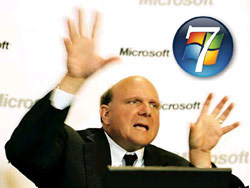Microsoft recently announced that it will put out six different versions of Windows 7 once the development process is complete, but you will only have to worry about choosing between three of them - in fact two, if you leave out Windows 7 Starter and Windows 7 Ultimate. Windows Communications Manager, Brandon LeBlanc, comes with some insight on why Microsoft made this decision.
“I wanted to take a closer look at the Windows 7 SKUs since there has been some discussion about them for the last couple of days. By the end of this post, I want you to know exactly which edition of Windows 7 is right for you and help you understand how we approached addressing the large amount of feedback we received,” he says.
There are several aspects that Microsoft needs to take into consideration when marketing Windows7:
- Which version to choose? To make things simpler, Microsoft will initially focus on just two versions: Windows 7 Home Premium and Windows 7 Professional. Other versions include Windows 7 Starter, which is meant for low powered machines, and Windows 7 Ultimate which is feature complete and addressed to technology oriented users that do not want to miss out on anything.
- Is it hard to upgrade from one version to another? Microsoft has made sure that upgrading is now easier than before with Windows Anytime Upgrade.
- Will I lose any features when I upgrade? No, you will not because each Windows 7 version is superset on the previous SKU: Starter -> Home Basic -> Home Premium -> Professional -> Windows 7 Ultimate.
- Why this SKU market distribution? Simply because the needs of users in specific markets vary: “Not every customer has the same needs. In general, we discovered that most think we should have about 2 or 3 SKUs but there isn’t much agreement what “the right” SKUs should be. So we are accommodating specialized needs for customers in specific markets,” says Brandon LeBlanc.
In terms of Windows 7 security, there has been talk lately about two flaws which affected the UAC (User Account Control) – a person with malicious intent could disable UAC altogether or make changes without prompting the user; a malicious application could elevate its privileges.
Long Zheng, the one who blew the whistle on Microsoft, comments: “It seemed only hours ago Microsoft stood by their decision not to change the UAC control panel behavior in Windows insisting it was “by design”. Oh wait, it was only hours ago. Nevertheless, three hours and numerous comments later, Microsoft reversed their decision for the better of all Windows 7 users.”
Yes, Microsoft who until now said the UAC does not present a security risk and will not make any changes in future versions of the OS, is now coming out to announce that with Windows 7 RC (Release Candidate) it will ensure UAC “will run in a high integrity process, which requires elevation” and will prompt the user for confirmation whenever UAC settings are modified.
“I wanted to take a closer look at the Windows 7 SKUs since there has been some discussion about them for the last couple of days. By the end of this post, I want you to know exactly which edition of Windows 7 is right for you and help you understand how we approached addressing the large amount of feedback we received,” he says.
There are several aspects that Microsoft needs to take into consideration when marketing Windows7:
- Which version to choose? To make things simpler, Microsoft will initially focus on just two versions: Windows 7 Home Premium and Windows 7 Professional. Other versions include Windows 7 Starter, which is meant for low powered machines, and Windows 7 Ultimate which is feature complete and addressed to technology oriented users that do not want to miss out on anything.
- Is it hard to upgrade from one version to another? Microsoft has made sure that upgrading is now easier than before with Windows Anytime Upgrade.
- Will I lose any features when I upgrade? No, you will not because each Windows 7 version is superset on the previous SKU: Starter -> Home Basic -> Home Premium -> Professional -> Windows 7 Ultimate.
- Why this SKU market distribution? Simply because the needs of users in specific markets vary: “Not every customer has the same needs. In general, we discovered that most think we should have about 2 or 3 SKUs but there isn’t much agreement what “the right” SKUs should be. So we are accommodating specialized needs for customers in specific markets,” says Brandon LeBlanc.
In terms of Windows 7 security, there has been talk lately about two flaws which affected the UAC (User Account Control) – a person with malicious intent could disable UAC altogether or make changes without prompting the user; a malicious application could elevate its privileges.
Long Zheng, the one who blew the whistle on Microsoft, comments: “It seemed only hours ago Microsoft stood by their decision not to change the UAC control panel behavior in Windows insisting it was “by design”. Oh wait, it was only hours ago. Nevertheless, three hours and numerous comments later, Microsoft reversed their decision for the better of all Windows 7 users.”
Yes, Microsoft who until now said the UAC does not present a security risk and will not make any changes in future versions of the OS, is now coming out to announce that with Windows 7 RC (Release Candidate) it will ensure UAC “will run in a high integrity process, which requires elevation” and will prompt the user for confirmation whenever UAC settings are modified.

























